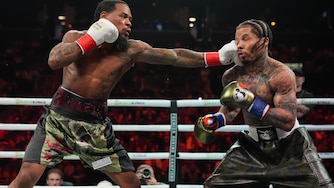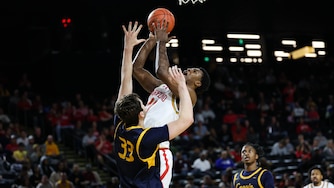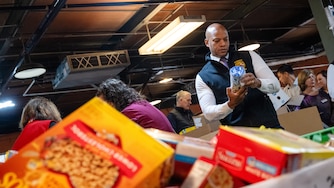They traded for pitching in bunches at last year’s deadline. They added a group of one-year stopgaps to the rotation in free agency. And now the Orioles have traded as many of those arms as they could to yield more long-term assets to throw at the singular problem facing this club: building a sustainable and top-caliber pitching staff to help this team get back to and win in the playoffs.
Their circular efforts are an extreme example of what can happen when a team must look elsewhere for pitching, as the Orioles have for a long time. Even modest upgrades can be costly, and the whole pitching space is so volatile that returns aren’t guaranteed.
The Orioles continue to scale a minor league pitching program meant to help support that goal, and over the last week they have added more talent. That will cover the sustainable part.
What the last year has shown is that the margins are too fine for this team to traffic in anything other than the highest-caliber arms available, and that’s an adjustment they need to make quickly. How the last year played out should give them plenty of evidence to consider on how to go about that.
“This whole thing is built on pitching,” interim manager Tony Mansolino said. “Everything in Major League Baseball, every team that sustains success, it’s pitching, pitching, pitching. Rarely is it a position-player-first mode. ... For the Baltimore Orioles to move forward and get back to what it is, it’s getting the health back of the pitchers that we have, and I think that’ll be the biggest step forward.”
Health precipitated all of these moves in the last year-plus. The club lost John Means, Kyle Bradish and Tyler Wells to elbow injuries in the first half of 2024, and general manager Mike Elias, by his own admission, took the issues on the mound as a prompt to aggressively add arms at the 2024 trade deadline. The rotation was threadbare, and a bullpen missing Félix Bautista was on shaky ground with Craig Kimbrel replacing him.
Read More
Those efforts yielded starters Zach Eflin and Trevor Rogers, plus relievers Seranthony Domínguez and Gregory Soto, all of whom came with the added benefit of being under contract for 2025 as well, helping narrow the club’s offseason shopping list.
Although they made a run to re-sign Corbin Burnes, he and the rest of the top starters on the market chose other clubs, so the Orioles’ offseason business led to all short-term deals. They signed starters Tomoyuki Sugano and Charlie Morton on one-year contracts, with Andrew Kittredge added to the bullpen on a deal that contains a 2026 option and Kyle Gibson signing late in spring.
Many felt it was underwhelming in the moment, considering the club has significant resources under its new ownership group and these value signings didn’t read as very ambitious for a team looking to return to the playoffs and perhaps win a game this time.
They obviously thought, with a healthy Grayson Rodriguez, the rotation would be good enough to support a top-tier offense and bullpen, and the starters fit the team’s desired archetype of durable pitchers who fill the strike zone and command a variety of pitches around the plate.
There was roster subtext to it, too. They didn’t lock into any longer-term deals as they waited for the returns of Bradish and Wells from elbow surgery, and they kept a lot of financial powder dry for higher-profile pitching acquisitions in future years.

I think there’s merit to the idea that the Orioles should have swallowed hard and left their comfort zone to support a better rotation over the last year, and that there’s merit to the way they’ve done it, even as the outcome didn’t work.
The struggles of these trade and free-agent additions had a lot to do with why they were deadline sellers in a lost season. Rogers’ offseason injury created a significant what-if, given how well he has pitched so far. But combine Morton’s disastrous April, Gibson’s failure to launch, Eflin’s post-injury homer woes and Sugano’s regression, and you have a dozen starts in which they allowed five runs or more and the Orioles lost. Not to paint with too broad a brush, but that’s their season.
If Eflin hadn’t returned to the injured list for a third time this year, he’d surely have been dealt. Sugano didn’t have enough of a market to warrant moving him. Soto and Domínguez were fit for purpose as part of a strong back end of the Orioles bullpen this year, but the need to trade for them in the first place feels like one the club will want to avoid going forward.
“This whole thing is built on pitching,”
Interim manager Tony Mansolino
The question for all of this is how they fix it. It’s easy to forget Rogers was part of this cohort of deadline additions, too, and there’s no discounting his success or how the club helped him get to this point.
Just acknowledging that feels dangerous, though. The Orioles have demonstrated so much conviction in how they identify and improve pitchers, primarily on the minor league side, that there’s a risk they’re relying too heavily on it all working out — and this is coming from someone who feels the minor league pitching depth chart features more than a handful of major league starters and countless others who can contribute in the bullpen.
Can Elias and his front office wait for those pitchers and the ones they added to the mix this month to help the Orioles, given how their efforts to bridge that time gap have gone so far?
Continuing to do so with short-term options, many of whom aren’t as good as their peers who warrant longer deals, is a dangerous game. There’s a lot of intellectual merit and logic to how the Orioles tried to put this staff together. It’s not a bad idea in theory, but it didn’t work — that’s why these trades happened last week. And, although it’s not exactly sound decision-making to abandon the processes that led to this because they didn’t work out in this instance, running the stopgap strategy back feels far too risky.
I’m not saying the Orioles shouldn’t believe in the pitchers who are storming toward Camden Yards, with Trey Gibson, Nestor German, Braxton Bragg and Michael Forret higher up the system and the fast-rising Esteban Mejia at Low-A Delmarva. They should, and for good reason. There are going to be more homegrown starters and a bullpen full of their own pitchers here soon enough.
“These last couple seasons have shown us, pitchers are going to get hurt and you need a lot of them,” Elias said.
“We have a lot of really good ones. And this is probably as strong as our pitching stable has been in the last few years, so I hope these guys stay on track. Brought a lot in at the deadline, but also the guys that we’ve drafted and signed internationally, and have internally here with the Orioles, there’s quite a bit to like there, and I feel good about our pitching stable right now. And we’re going to need it.”
Until pitchers in that pipeline reach Baltimore, they’re going to need more. Be it another major trade, a la Burnes ahead of the 2024 season, or the kind of statement free-agent signing that the team hasn’t made on the mound in the offseason, the bridge to that moment needs to be a higher-quality one than they built this year. It also can’t be a temporary one, as we’ve found out.
For this competitive window to be built to last, the pitching staff needs to be, too.





Comments
Welcome to The Banner's subscriber-only commenting community. Please review our community guidelines.